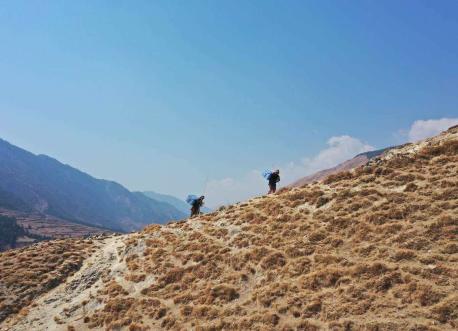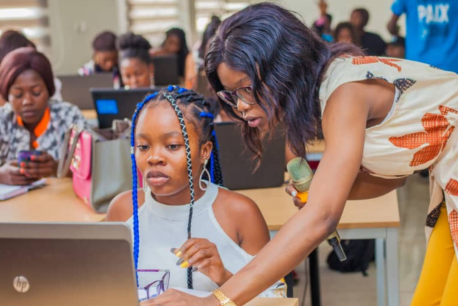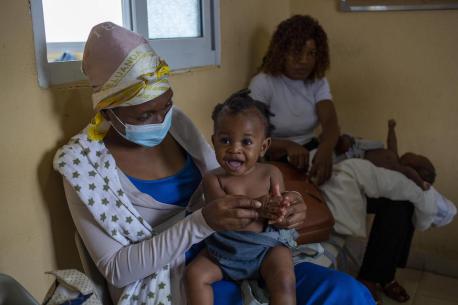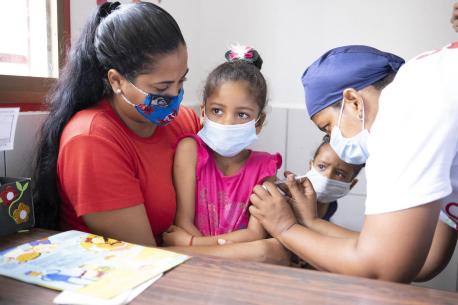
Crossing Mountains and Rivers to Deliver COVID-19 Vaccines
“I came here by road from Kathmandu, Nepal. It took five days to arrive at this place,” says Indra Kala Tamang, UNICEF Health Officer.
Tamang is in Jumla, one of the most remote districts of Nepal's Karnali Province, to help ensure COVID-19 vaccinations run smoothly. The difficult geography in this region of Nepal means that after vaccines arrive in the country by air, many must be carried to their destination by porters on foot. Fresh off a deadly surge of coronavirus — the second to hit the country — Nepal knows that ensuring everyone gets the COVID-19 vaccine is the only way to end the suffering and the pandemic.

“It’s truly gratifying to see how UNICEF’s support to the cold chain at different levels is being used in this vaccine drive to reach far-flung communities,” says Tamang (above).
I came here by road from Kathmandu, Nepal. It took five days to arrive at this place. — Indra Kala Tamang, UNICEF Nepal Health Officer
UNICEF's work strengthening Nepal's cold chain system pays off as COVID-19 vaccines travel safely to those hardest to reach

UNICEF and partners have spent years strengthening Nepal's cold chain system, providing refrigerators, freezers, cold boxes and carriers along with other logistical and technical support. Today, these efforts are paying off as COVID-19 vaccines make their way to the country's furthest reaches.
The second phase of the campaign in Nepal is meeting little resistance. Tamang reports that the majority of people are excited to get their COVID-19 vaccination.
Community health volunteers go door to door, even calling senior citizens on the phone to urge them to get their COVID-19 vaccines
“Health workers in this area are very active,” says Tamang. "They do home visits, and they also do counseling and mobilizing of women who are community health volunteers."
Chaitee Rawat, 81, is just one person who was glad to get the call that the COVID-19 vaccines were in. After learning COVID-19 vaccines were available, she wasted no time in getting hers.

“I have heard of the coronavirus. It is scary to think it can kill you," says Rawat (above), who got her jab the day after the vaccines arrived. "I’m very excited to get the shot. Why wouldn’t I be happy to get the vaccine?”
"I’m very excited to get the shot." — Chaitee Rawat, 81, Jumla, Nepal

Above, people gather to wait for their COVID-19 vaccine outside a health post in Jumla District in Nepal's remote far west. In addition to vaccinating the elderly (like the women above), people with comorbidities and teachers, Nepal also included refugees in the second wave of its immunization campaign, becoming the first country in the Asia-Pacific region to do so.
As a key partner of the COVAX Facility, a global multi-agency effort to ensure equitable access to COVID-19 vaccines, UNICEF is leading on vaccine procurement and providing on-the-ground support to prepare for and facilitate vaccine rollouts around the world. In 2020 alone, UNICEF installed 290 pieces of cold chain equipment throughout Nepal to ensure COVID-19 vaccines remain safe and effective in the last mile of their journey.
You can help UNICEF rush critical lifesaving supplies, services and vaccines to protect health workers and families in Nepal and surrounding countries. Please donate today.
All photos: © UNICEF
HOW TO HELP
There are many ways to make a difference
War, famine, poverty, natural disasters — threats to the world's children keep coming. But UNICEF won't stop working to keep children healthy and safe.
UNICEF works in over 190 countries and territories — more places than any other children's organization. UNICEF has the world's largest humanitarian warehouse and, when disaster strikes, can get supplies almost anywhere within 72 hours. Constantly innovating, always advocating for a better world for children, UNICEF works to ensure that every child can grow up healthy, educated, protected and respected.
Would you like to help give all children the opportunity to reach their full potential? There are many ways to get involved.





